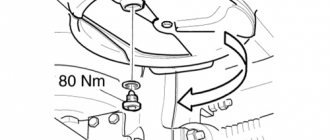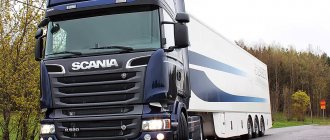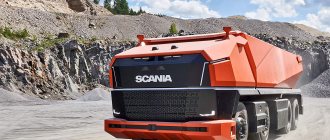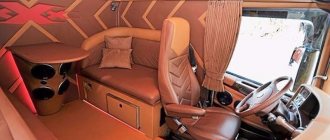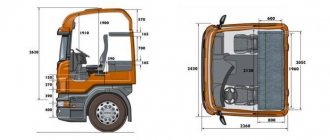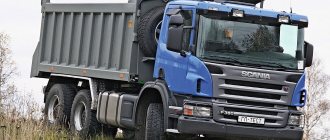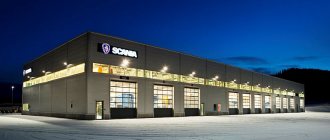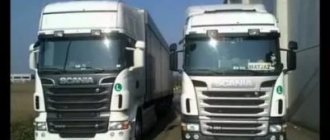Truck tractor (Turck) Scania G400 LA4x2 HNA ID: 99442 Year of manufacture: 2012 (Start of operation 2013) Mileage: 625,842 km Wheel formula - 4x2 | Number of axles: 2 Transmission type - Mechanical 12-speed | Make and model of gearbox - SCANIA GRS895 Single-plate clutch with overload protection. Engine power - 400 hp. (294 kW) at 1,900 min-1 | Engine displacement - 13,000 cm3 Max. torque 2100 Nm at 1000 – 1 300 rpm Engine model: DC12 23L01 Engine brand: SCANIA | Engine type: Diesel with turbocharger Ecological fuel class — Euro 4 Permitted maximum weight - 19,000 kg | Weight without load: 8,190 kg Load per axle – 7,500 kg | Load on 2nd axle – 10,500 kg The maximum permissible weight of the road train is 40,000 kg Cabin type - CG19N medium two berths | 4-point air suspension with stabilizer SSU height: 1150 mm | Fifth wheel JOST JSK37C-Z, 2″/150 mm Final drive R780 single-stage, hypoid, 1:2.92, with differential lock Suspension type — Combined Brake type — Ventilated disc Fuel tank volume - 1,150 liters 1st 500L Aluminum Fuel Tank | 2nd fuel tank 650 liters | Lockable fuel filler cap Wheelbase - 3,700mm
Steering wheel: Left Color: Yellow Condition: Excellent
Middle peasants Scania in the Russian Federation
Scania Griffin is a project that was developed specifically for the Russian transport market. We tried to provide the vehicles of this series with the characteristics that are most in demand by domestic carriers and meet the criteria for the quality and reliability of trucks in our conditions. Scania Griffin was awarded the "Best Foreign Truck of the Year in Russia" award in 2002 and 2007. The project has become a proprietary system product, which includes a complex of technical, operational, financial and economic operations for the acquisition and operation of Scania trucks.
The luxurious R-series conquerors of long-distance highways were imported en masse to the Russian Federation in the early 2000s - well-fed pre-crisis times. Moreover, both official dealers and second-hand dealers. And the G-series appeared later - in Russia these cars began to be officially sold only in 2008 - already in an updated version, and they were just in time for the first stage of the crisis in the domestic economy.
The Scania assembly plant in the Leningrad region does not produce these truck tractors: it is focused on the assembly of dump trucks. Those new G400s that are sold by official Scania dealers in Russia come mainly from factories in Sweden and Holland, and less often from the company’s Brazilian plant.
Currently, the Russian representative office of Scania presents truck tractors in more than thirty standard versions on our market - not counting the various configurations and options. The most common were and remain two-axle 4x2 tractors; rarer ones are also available - with a 6x4 wheel arrangement. Well, three-axle all-wheel drive 6x6 is an exclusive, one-piece product. Which, nevertheless, is in production.
Cabins P and G are mounted lower on the tractor frame than cabins R, so their engine compartment shaft protrudes more significantly into the interior of the cabin. In addition to the basic version of the Scania G400 truck tractor, there is also the Highline Streamline version - a line of long-haul trucks with improved fuel efficiency, aerodynamics and interior trim. They are equipped with the optimized Scania Opticruise gearbox.
Cars of the Scania G400 model have been mass-produced since 2006, and with each “upgrade” (the most significant was in 2013) they become even more comfortable inside and more respectable outside. These machines are extremely safe and convenient to operate, and business ownership and operation are highly efficient. The fleet management system (FMS) and new service solutions provide the ability to download vehicle diagnostic data in remote access mode to increase the useful time of the truck, and, on the contrary, reduce the time spent visiting the service center.
The transport task of the Scania G400 / G400 Highline Streamline truck tractors is long-distance freight transportation, including international ones. These machines are ideal for a variety of types of semi-trailers: tent, isothermal, refrigerated.
Size doesn't matter
The next run simulated work on public roads and did not present any surprises until I got to the mountain serpentine. It was very pleasant to watch how a truck of considerable size and tonnage simply playfully fit into the narrow curves of the connected turns. The reason for this, of course, is the steering rear axle. Such equipment will certainly appeal to various public utilities and organizations involved in the construction and operation of roads; The G 400 CB6x6HHZ will load itself and deliver bulk cargo in any conditions to any final transportation point. Regardless of whether it will be a narrow street of an ancient European town or a construction site high in the mountains.
In conclusion, I would like to return again to the conversation about the new automated gearbox. I hope that the shortcomings I discovered are just “childhood illnesses” that will become a serious and respected car in the near future. Then you can look at Scania Opticruise differently. The system adds about 2,500 euros to the cost of the car. Meanwhile, it will, to a greater extent, allow the owner to save the car from the hands of bunglers and incompetents, and will pay for itself. But a real pro will still be skeptical about fashionable options, but, being very tired at the end of the shift, will still give the automation a good word.
G400 frame, chassis, suspension and running gear
The tractor frame is welded from powerful side members F 95O, 27O x 9O x 9.5 mm. The maximum permissible load on the front axle is 75OO kg. The maximum permissible load provided for the rear axle is 115OO kg. The wheelbase of the car is 370 mm.
The front suspension design includes parabolic springs, W x29. The rear suspension is pneumatic, double-cylinder. The wheel size on both the front and rear axles is 9.0 x 22.5 inches; tires - З15/7О R22.5.
The tractor chassis uses a JOST JSK37C-Z 15O fifth wheel coupling device. Fifth wheel coupling plate – 22 mm, D-value max 152kN. The fifth wheel position is 660 mm; its height is 1150 mm. The braking system is electronically controlled (EBS). The type of truck brakes is drum.
Maneuvers
But since they say: it’s possible, we must try. In the end, the soil is soft, it will only get dirty, but not damage the body, and the car’s traction should be enough to overcome the “jam” and not slip. If you turn on all possible locks, they will inevitably increase the turning radius, then I will lock the interaxle and leave the ability to control the rear axle by placing the selector in the second position. The car, albeit at very small intervals, literally fit right into the turn. Then the path lay through a very beautiful quarry, where local rock is being mined, and at the exit there is a wonderful climb - it’s time to try driving on an incline and see how the vaunted Scania Opticruise system works. Stop, handbrake, neutral.
I move the steering column transmission control lever to the “AO” position, which corresponds to the automatic operating mode in off-road conditions, smoothly release the brakes, at the same time press the fuel pedal and... roll back, roll back. After about two meters I got tired of it, and I braked the car.
I did the next take, working the brake pedal like a clutch on a manual transmission. Smoothly releasing the service brakes, I synchronously added gas and set off up the mountain, and at the end of the climb, when the effective engine speed had dried up, I was still waiting for Opticruise to deign to switch to a lower gear, but, alas, the truck twitched and stalled. No good!
Immediately after the race, I, of course, asked a question and received an answer. The point, it turns out, is that Scania Opticruise is an adaptive and self-learning system. It accumulates certain data and intelligently optimizes the parameters only after seven or even ten days of operation, and my car is still completely “green”. I believed it, because something similar is included in the transmission control algorithm of my personal Mitsubishi Lancer X 2.0, equipped with an adaptive variator. Having escaped from a long Moscow traffic jam, he also thoughtfully responds to the right pedal for some time, as if urging him to save fuel rather than accelerate intensively. And in the case of the Scania truck, it turns out that the young fighter’s course for the Scania Opticruise transmission must be taught either by the dealer or by an experienced driver who will deliver the vehicle to the place of work.
After going up there is always a descent. The test sample was not equipped with a retarder, but there is a floor-mounted downshift switch on the left under the driver’s feet; I was pleased with the efficiency of his work.
Technical characteristics of the Scania G 400 CB6x6HHZ6x6 Euro 5 dump truck
| Total weight, kg | 35 000 |
| Permissible load on front/rear axle, kg | 9000/ 26 000 |
| Load capacity, kg | 22 000 |
Engine:
| Scania DC13 05 (Euro 5) 12.7 400 at 1900 min-1 2100 at 1000–1300 min-1 |
Transmission:
| Scania Opticruise, automated 12/ 2 |
| Suspension front/rear | Multi-leaf springs/hydraulic |
| Tires | 13,R22.5 |
Engine Scania G400 / G400 Highline Streamline
This car is equipped with a turbocharged diesel engine, engine model DC13 103. This is a four-stroke six-cylinder diesel engine with in-line cylinders. Its predecessor (also an inline 6-cylinder DC12) was available until 2012. The trucks currently sold and operating in Russia are equipped with engines that meet the environmental standards of Euro-4 (SCR) and Euro-5 standards. Diesel power DC1Z 1OZ – 4OO horsepower (294 kW), at 19OO rpm. The maximum torque of 21OO N∙m is achieved at 100-1400 rpm. The working volume of this power unit is 15 6OO cubic centimeters. There is an automatically controlled engine brake.
The truck's fuel system includes an aluminum fuel tank located on the left side with a capacity of 600 liters of diesel fuel. As well as a urea tank of 75 Dm3 (modified with the DC13 103 engine, adapted to Euro-5 standards). A heated fuel filter-moisture separator is installed. The exhaust pipe is directed backwards, not upwards.
A signature feature of Scania engines are separate cylinder heads. And also - a wide unification of parts among engines of different displacements and purposes. For example, on a 5-cylinder DC9 the piston stroke is 140 mm, on a 6-cylinder DC13 it is 160 mm, which, with a single cylinder diameter of 130 mm, gives in the first case 9.3 liters of working volume, and in the second - 12.7 liters. Moreover, both engines are structurally the same - with cast iron blocks, “wet” cylinder liners, a rod valve drive from a lower camshaft and a timing drive from the flywheel side.
The lubrication system contains a centrifuge operating parallel to replaceable filters - a rarity in modern engine building. To reduce vibrations, the DC9 inline-five uses two balancer shafts. A feature of DC13 motors of Euro-4 and Euro-5 classes is also that cars for the Russian market are equipped with a power supply system with PDE unit injectors from Bosch, instead of the Common Rail equipment used on Euro-6 engines for the rest of Europe ( XPI). In recent years, the engines of all cars officially supplied to Russia have been equipped with a urea solution injection system.
Transmission and axles Scania G400
The design uses a mechanical clutch, single-disc type, with wear protection. Gearbox – mechanical, model GRS905 12+2-speed, with range and divider, with two reduction gears and two reverse gears. The main gear is single-stage, hypoid. Its model is R780. There is a differential lock. The main gear ratio is 1:2.92.
In general, operating experience demonstrates that the GRS905 gearbox, coupled with a diesel engine, provides decent traction and high efficiency. Diesel fuel consumption is at the level of 32-35 liters per 100 km, in the combined cycle. These are excellent figures for a car of this class. The maximum speed of the tractor unit is limited to 90 km/h.
The gearbox with a Scania range multiplier (the Scandinavian manufacturer is one of the few who makes their own transmissions) is distinguished by the ease of design and operation of the levers. The use of Scania Opticruise and Scania Retarder systems is also very effective.
The GRS905 gearbox is perfectly adapted to conquer even the most difficult routes, and is a proven specialized product for long-distance cargo transportation. The close gear ratios of the higher gears allow the driver to easily maintain a high vehicle speed without going beyond the green zone of economical driving.
In situations where low-speed traction is required, this transmission is equipped with additional crawler gears. The GRS905 is economical to operate and excels at typical construction, regional and local trucking applications. The version with overdrive transmission also allows for the transmission of very significant torque and is used when low and economical speeds are required. This transmission is well suited for light, most economical driving of a heavy truck.
Also, for this type of Scania manual gearboxes with range multipliers, it is possible to install several options for the power take-off device. Scania power take-offs are multifunctional and designed for a wide variety of applications.
The G400 drive axles, also Scania's own, are designed to ensure minimal friction in any application. Wherever the gear teeth mesh with each other, friction occurs, which increases diesel fuel consumption. Therefore, careful design of all gears and drive bearings has been carried out for many years to improve the vehicle's fuel efficiency. However, the main qualities of Scania axles remain their strength and lightness.
Technical characteristics of the Scania G400 tractor
The length of the car is 5398 mm, of which 3700 mm is the distance between centers. Width 2430 mm (without side mirrors) and height 3270 mm. The fifth wheel coupling is located at a height of 1150 mm.
Engine Scania G400
The car is equipped with a 13-liter in-line DC13 103 engine with a power of 400 horsepower and a torque of 2100 N • m. This is a six-cylinder four-stroke engine with direct injection and intercooling with turbocharging.
A distinctive feature of the installed “engine” is separate cylinder blocks. The Scania G400 engine complies with the Euro 4 (SCR) environmental class in models manufactured before 2012, or Euro 5 in later versions of the tractor. The power supply system consists of:
1 Main and additional fuel tanks with a capacity of 600 and 500 liters respectively. 2 urea tanks with a volume of 75 dm3. 3 Heated fuel filter-drier. 4 Exhaust pipe facing rearward.
The lubrication system has such a rarity in modern engine building as a centrifuge that works simultaneously with a replaceable filter.
Tractors with Euro-4 and Euro-5 engines intended for the Russian market are equipped with a fuel system with a Bosch PDE fuel pump combined with an injector, and for sale in the EU - a Euro-class internal combustion engine.6 with XPI equipment installed (Common Rail) .
Technical characteristics of the trolley are given in the table
Useful: Rolling resistance of car tires
| Characteristics | Values |
| Overall dimensions (L x W x H), mm | 5398 x 2430 x 3270 |
| Empty weight, kg | 8190 |
| Total weight, kg | 19000 |
| Weight distribution on front/rear axle, kg | 7500/11500 |
| Engine, power, hp together with. | 6-cylinder turbodiesel DC13 103, 400 |
| Volume, l | 13 |
| Torque, N m | 2100 |
| Fuel tanks, l | 600 + 500 |
| Fuel consumption, l/100 km | 30 |
| Transmission of infection | 12 + 2 stages GRS905 |
| Maximum speed, km/h | 85 |
Chassis
The front suspension of the Scania G400 tractor is dependent, with longitudinally located 3x29 parabolic springs. A transverse stabilizer of normal stiffness is located on the front axle. Bi-directional telescopic shock absorbers.
The rear suspension is equipped with two rubber air springs. Stainless steel caps. The chassis level is adjusted using a button located on the dashboard.
Brake system
For a large car used for long trips, the reliability of the braking system is important. SCANIA specialists have made a lot of efforts to ensure that the car complies with accepted international standards.
The tractor's braking system is dual-circuit pneumatic with a direct action mechanism, corresponds to category AE. It is combined with the trailer's attached brake shoe. The brake control system is electronic, with PBS and ABS.
The “engine” retarder is automatic. Reliable parking brakes on both axles ensure safe parking on steep slopes. For braking, 250 mm thick pads are used.
Transmission and gearbox G400
The tractor has a single-disc mechanical clutch with wear protection. GRS905 12+2 gearbox, with divider and range for increased torque. There are two reduction gears and two reverse gears. The final drive of the R780 model is a single-stage hypoid with a differential lock with a gear ratio of 1: 2.92.
SCANIA is one of the few manufacturers that install branded transmissions on their cars. Thanks to the intelligent automatic system Scania Opticruise, gear changes are easy and smooth. The driver can set automatic gear shifting independently or manually using a lever located on the steering column. A clutch pedal is also installed for precision maneuvering, stopping and smooth starting.
The carefully thought-out design of the GRS905 gearbox in combination with the diesel internal combustion engine provides excellent traction characteristics and high efficiency for vehicles in this class. The gearbox is suitable for implementing routes of any complexity when transporting goods over long distances. Thanks to the proximity of the higher gear ratios, the driver can easily maintain the required tractor speed while staying within the green zone of economical driving.
The GRS905 is equipped with additional reduction gears that are inserted for low speeds. Thanks to the presence of an overdrive gear, maximum torque is transmitted, which is used when it is necessary to drive the car at low or economical speeds.
This type of transmission provides the most economical driving at the optimal speed of a heavy tractor. In addition, for a manual transmission with range multiplier type GRS905, several options for multifunction power take-offs can be added at the same time.
Steering and instrument panel of a tractor unit
The tractor is equipped with power steering. The steering wheel is adjustable, with a cruise control on/off button. The instrument cluster is made in the traditional style for most Scania models with a combination of COLOR devices.
Useful: Reviews from KAMAZ drivers
It extends almost the entire width of the cabin and rotates slightly to make it easier to see the instruments. Traffic control and adherence to sleep and rest patterns are carried out using the Shtrikh-M tachograph, configured for two drivers.
To determine the location of the vehicle and immediately identify problems, an FMS telemetry system with a “Monitoring” block is installed on the dashboard. Steering wheel with black leather upholstery. If necessary, the gear shift lever can be lowered.
Electrical equipment Scania G400
The truck tractor is equipped with batteries with a capacity of 225 Ah. The battery switch type is double, one in the cab and one on the left side of the chassis. Generator – 100 Ampere.
The rear view mirrors are electrically adjustable and electrically heated. There is a manually operated hatch in the cabin roof. The lighting is equipped with a headlight level corrector. Fog lights are standard on the truck. There are headlight cleaners. Head lamp type – H4 (24 V). The steps leading to the cabin are equipped with electric lighting. The bumper has additional high beam headlights. There is an orange road train sign (with a switch).
Streamline driver's cab
The G series tractors are equipped with a double cab CG 19 N. The interior design is rational and solid. The driver's seat is equipped with a heating system designed to meet the high demands of professionals for comfort while driving.
The anatomically shaped premium seat with air suspension and adjustable stabilizer automatically adjusts to the driver's weight. The seat cover is made of durable, non-marking fabric that is pleasant to the touch. The passenger seat does not have suspension, but can be easily folded if necessary.
For relaxation and sleep, the cabin has two comfortable berths, allowing you to fully recover on a long journey. The width of the lower bunk is 70 cm, which is quite enough for relaxation. The top shelf is slightly narrower - its width is 60 cm.
The Scania G400 cab is equipped as standard with an air conditioning system and a tinted windshield. For heating, a “dry” heating element with a power of 2 kW is installed in the cabin. The rear view mirrors rotate electrically. To prevent freezing, the mirrors are heated.
On the instrument panel next to the passenger seat there is a convenient box for storing personal documents, invoices for transported cargo, and invoices. There is also additional storage space located in the door pockets and side walls of the cab. Remote control of central locking. For the convenience of eating and relaxing, a folding table is installed in the cabin.
Natural ventilation is provided by air intake through the skylight. Personal items and replacement bedding sets are stored in a drawer that slides out from the bottom of the bed for sleeping. The premium radio is controlled by buttons on the steering wheel.”
Cabin Scania G400
In general, cabs for Scania G series vehicles are produced in 5 standard sizes, including even the short, “purely day and tipper” CG14. On long-haul tractors (with the exception of car transporters), the two most spacious types of cabins are used: CG19N and CG19H, where 19 is the internal length in decimeters.
The Scania G400 truck tractor is equipped with a G series cab, model CG19N. This is a medium-height cab (higher in the Scania G400 / G400 Highline Streamline series than in the regular G400). The cabin is mounted on a frame with air suspension at four points. The cabin stabilizer has a normal degree of rigidity.
The Scania G400 Highline trucks have a higher CG19H cab, the internal height of which from the driver's foot mat to the ceiling is the same as in the Highline cab of the older R-series (1910 mm). The difference in the size of the cabins of these two series is only in the height of the “podium” in the middle, that is, the tunnel above the engine (in the “Erk” it is 160 mm lower), and in the inaccessibility of the Topline cabin for the G-series - the one that has an internal height 2230 mm.
The design of the cabin interior of this car is thorough, rational, and neat in a Scandinavian way. The driver's seat in the cabin of this truck tractor is installed in a premium class, with a comfortable anatomical shape, on air suspension, and equipped with electric heating. The upholstery of the driver's seat is made of high-quality wear-resistant fabric. The passenger seat does not have suspension, but it can be easily folded. There is a small and convenient folding table.
The instrument panel is long, with a traditional Scanian turn toward the driver. The steering wheel is trimmed in black leather. The gearbox control lever is foldable.
On the passenger side, right on the dashboard, there is a convenient document tray (with lid). Ample storage space is also provided in the cab's side walls and door pockets. The total width of the lower berth is 7OO mm; The width of the shelf of the upper berth is somewhat narrower - 600 mm. There is a spacious storage compartment under the lower berth.
The central locking is equipped with remote control. Air conditioning is included as standard. Also in the cabin there is an autonomous dry heater, 2 kW; Premium radio; tachograph "Shtrikh-M"; FMS telematics system with the Monitoring package.
Cabin interior
Once inside, the laconic Scandinavian design immediately catches your eye. The dashboard is oriented towards the truck driver according to all canons, allowing you to control all the adjustments. The panel is made simply, conveniently, without unnecessary complications. Dials with the necessary readings, on-board computer.
Switches and a multimedia system are located on the side. 4-spoke steering wheel with control buttons. It will become a little uncomfortable for people with large hands due to the thinness of the rim. The driver's seat of the G400 is made of fabric of very good quality. It received the function of adaptation to human weight, developed by Swedish engineers. Shock absorption and heating will help maintain comfort on the road.
The passenger seat is simpler, with simple adjustments. The cabin does not have a flat floor; a tunnel in the middle separates the space between the passenger and the driver. Even standing on a hill, a person of any size will feel free. A small table extends outward from the center of the panel. A branded coffee maker was optionally installed. There are various niches for things scattered throughout the space. The glove compartment hides a full-sized table. Under the bed of the Scania G400 there is a refrigerator of modest size.
The cabin is designed for two people. Only one person can sleep with proper comfort for a long time. But if necessary, spending the night together will not be a burden. The total width of the lower seat is 700 mm, the upper one is 600. The passenger seat folds down to form a bedside table. There is a modest reading lamp and an air conditioning unit to maintain the desired temperature when not in use. A hatch is visible above the head of the “sleeper”. Its controls are located on the back wall.
There is a mosquito net for ventilation, and there is also a sun curtain. It should be noted that the entire cabin can be closed from sunlight with curtains along the windows. All the plastic inside is made of high quality material. It is very pleasant to touch and also looks appropriate. The high cost of interior finishing materials made it possible to get rid of unpleasant noise when driving. In addition, the roundness of the truck helped reduce noise.
Reviews from Scania G400 owners and drivers
This model has earned an excellent reputation, and reviews on the Internet about working on Scania G400 truck tractors are almost one hundred percent positive. First of all, they praise the high quality of assembly, reliability and durability of all parts and components of the car. “Even for little things, like KamAZ (I also had 5 new KamAZs) - for tubes or hoses to fray, or for something to come loose - this has never happened with Scania at all.”
Few Scania G400 owners can share their experience of engine repair. The manufacturer promises a motor life of two million kilometers. And there are cars of this brand that (taking into account their “first life” in well-maintained Europe with excellent roads) have actually covered such mileage by this time. No engine repairs. Almost no one complains about the gearbox. But forgetful drivers still throw away the expensive drive axle gearbox from time to time: because the manufacturer did not provide “foolproof protection” that prevents driving with a locked differential on clean asphalt in this important unit.
The undoubted advantage of the model is good maneuverability and excellent visibility from the driver’s workplace, in all directions: “as they say, I’ll drive sideways into any dacha.” The cabin is warm and comfortable, the berth provides enough space even if you are 190 cm or taller – you don’t have to bend your legs when sitting on it. The air-suspended seat can be adjusted “to suit you” without the slightest problem. The steering wheel is also easy and comfortable to adjust. In general, the driver’s workplace of the Scania G400 is comfortable. The ergonomics are also excellent - everything is thought out to the smallest detail.
The driver sitting in the cab practically does not hear the engine noise on the road. The traction is excellent: even when fully loaded, this truck tractor confidently overcomes all the climbs that come its way. At the same time, it moves at cruising speed very smoothly and evenly.
A summary of the reviews as a whole is this: the Scania G400 is an almost flawless long-range vehicle. No modifications are required. Sit down and work, earn money. The ease of operation and reliability of the car give complete confidence that you should not be afraid to go on long trips. By the way, the fuel system of this truck is very undemanding when it comes to the quality of diesel fuel. Spare parts, components and consumables are relatively inexpensive (relative to other European “truck” automakers).
Therefore, the Scania G400 and the Scania G-series in general are one of the most common models of long-haul tractors from Europe in Russia. Scania tractors are not cheap compared to MAZs and KamAZs, and carriers often choose not the flagship R model, but a completely comfortable mid-size G-series vehicle. We have twice as many such Scanias as top-end R ones (although there are quite a few of them). Based on specific experience, this car will last up to a million kilometers and more, with minimal costs for spare parts, after which it can still be sold at a normal price.
Grouping
Before getting behind the wheel, I decided to read the description of the updated transmission, which I consider it my duty to briefly outline to the reader. So, the Scania Opticruise system is equipped with a new mode that allows you to select the optimal gear in off-road conditions and during construction transport. This mode is activated on the traction control panel, where all control systems are grouped. This should simplify the driver’s work and provide a way out of an unfavorable situation. The new version of Scania Opticruise can operate either in fully automatic mode or allows you to select gears manually. An interesting innovation of the system is the maneuvering mode, which ensures movement at extremely low speeds, and the automatic rocking mode, which itself detects slipping of the drive wheels. Some Scania Opticruise parameters can be adjusted at your dealer to adapt the system to your specific conditions. The gear intended for starting from a standstill is engaged automatically, but it can be reset to replace the default one. In off-road mode, the system tries to keep the clutch engaged for as long as possible, which reduces gaps in energy transfer and, therefore, traction. The number of gear changes is minimized in order to maximize the operating speed range of the engine; gear changes occur a little faster, which somewhat reduces driver comfort (shocks are felt when shifting).
